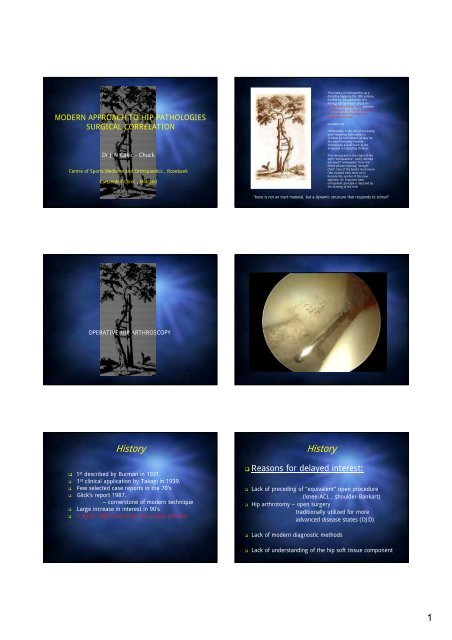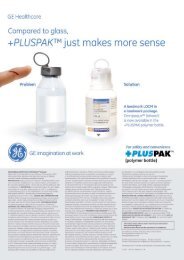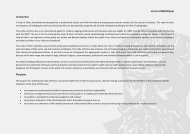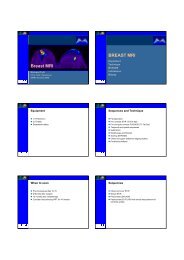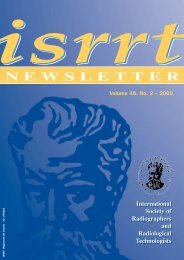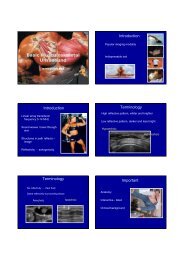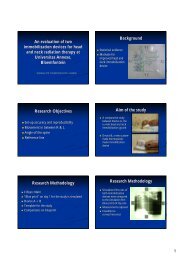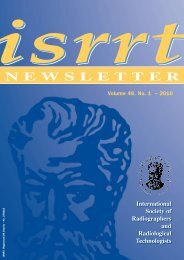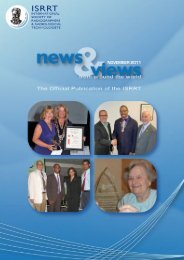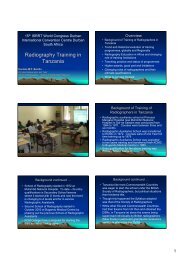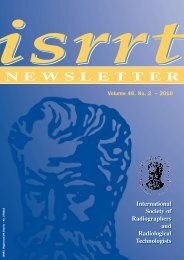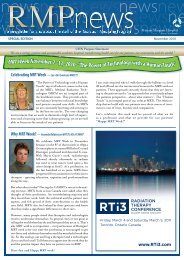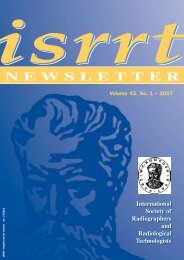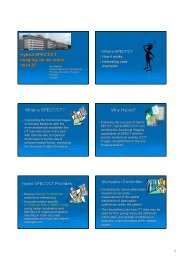images/isrrt/16H45 DR JN CAKIC RM 1A SESSION 3 FRIDAY.pdf
images/isrrt/16H45 DR JN CAKIC RM 1A SESSION 3 FRIDAY.pdf
images/isrrt/16H45 DR JN CAKIC RM 1A SESSION 3 FRIDAY.pdf
- No tags were found...
Create successful ePaper yourself
Turn your PDF publications into a flip-book with our unique Google optimized e-Paper software.
Two Broad CategoriesTwo Broad CategoriesAlternative to arthrotomyfor traditionally recognized forms of hip pathology Method of management for conditions that previously wereunrecognized and untreated:Loose bodiesSepsisArthritisPatients simply resigned to living within the constraints of their symptomsLabral tearsArticular injuriesRuptured ligamentum teresAnatomyLabrum and AcetabulumAdvantages of HipArthroscopyLabrumSoft rimCircumferentialAcetabulumDeepConcentricLig. TeresLess invasive vs..arthrotomyAllows surgeon to addressintraarticular derangementsthat were previouslyundiagnosed/untreatedRecent InterestPatient Assessment and SymptomsArthroscopic equipmentadaptations have led toimproved safety &visualizationImproved surgicaltechniquesBetter understanding ofanatomy andbiomechanics of hip jointImproved imagingtechniquesCharacteristic Exacerbations Symptoms worse with activities Straight plane activities relatively well-tolerated Twisting, such as turning changing directions Seated position may be uncomfortable,especially with hip flexion Rising from seated position often painful (catching) Difficulty ascending and descending stairs Symptoms with entering/exiting an automobile Difficulty with shoes, socks, hose, etc. (OA)2
Specific TestsSpecific Tests “C” sign Standing W/B rotation Log roll –intraarticular pathology Thomas testflexion contracture Forced Flex/IR“impingement test” Flexion/ABD/ERlabral/surface diseaseclicks - associated with labralpathology Resisted SLRlabral/surface disease“C” signStanding W/B rotationLog rollintraarticular pathologyThomas testflexion contractureForced Flex/IR“impingement test”Flexion/ABD/ERlabral/surface diseaseclicks - associated with labralpathologyResisted SLRlabral/surface diseaseSpecific TestsSpecific Tests“C” signStanding W/B rotationLog rollintraarticular pathologyThomas testflexion contractureForced Flex/IR“impingement test”Flexion/ABD/ERlabral/surface diseaseclicks - associated with labralpathologyResisted SLRlabral/surface disease“C” signStanding W/B rotationLog rollintraarticular pathologyThomas testflexion contractureForced Flex/IR“impingement test”Flexion/ABD/ERlabral/surface diseaseclicks - associated with labralpathologyResisted SLRlabral/surface diseaseSpecific Tests“C” signStanding W/B rotationLog rollintraarticular pathologyThomas testflexion contractureForced Flex/IR“impingement test”Flexion/ABD/ERlabral/surface diseaseclicks - associated with labralpathologyResisted SLRlabral/surface diseaseRadiographic investigationXR’s:s: Poorly indicative of problemsamenable to arthroscopic interventionMcCarthy & Busconi, Orthop ‘9595Insensitive indicator of early OASantori & Villar, Orthop ‘993
Radiographic investigation Helpful identifying morphologicalvariants predisposing to intraarticularpathology Femoroacetabular impingementPincer Pincer type(acetabular retroversion) Cross-over over sign Posterior wall sign Femoroacetabular impingementCam-type(proximal femur)→Radiographic investigationMRIHigh resolution MRI1.5 Tesla magnet; surface coilReliability improvingStill up to 80% false negativeIndirect evidence mostreliable (effusion; paralabralcyst; subchondral cyst)MRI arthrogramGreater sensitivity(8% false negative)20% false positive(double that of MRI)Loose bodiesIndicationsIndicationsIndicationsLoose bodiesLabral tearsLoose bodiesLabral tearsDegenerative arthritis4
IndicationsIndicationsLoose bodiesLoose bodiesLabral tearsLabral tearsDegenerative arthritisDegenerative arthritisAVNAVNChondral injuriesIndicationsIndicationsLoose bodiesLoose bodiesLabral tearsLabral tearsDegenerative arthritisDegenerative arthritisAVNAVNChondral injuriesChondral injuriesPipkin fracturesPipkin fracturesSynovial disease, BiopsyIndicationsIndicationsLoose bodiesLabral tearsDegenerative arthritisAVNChondral injuriesPipkin fracturesSynovial disease, BiopsyRuptured ligamentum teresLoose bodiesLabral tearsDegenerative arthritisAVNChondral injuriesPipkin fracturesSynovial disease, BiopsyRuptured ligamentum teresSynovial chondromatosis5
IndicationsIndicationsLoose bodiesLabral tearsDegenerative arthritisAVNChondral injuriesPipkin fracturesSynovial disease, BiopsyRuptured ligamentum teresSynovial chondromatosisAssociated with open surgeryLoose bodiesLabral tearsDegenerative arthritisAVNChondral injuriesPipkin fracturesSynovial disease, BiopsyRuptured ligamentum teresSynovial chondromatosisAssociated with open surgeryUnresolved hip painIndicationsIndicationsLoose bodiesLabral tearsDegenerative arthritisAVNChondral injuriesPipkin fracturesSynovial disease, BiopsyRuptured ligamentum teresSynovial chondromatosisAssociated with open surgeryUnresolved hip painOsteochondritis DissecansLoose bodiesLabral tearsDegenerative arthritisAVNChondral injuriesPipkin fracturesSynovial disease, BiopsyRuptured ligamentum teresSynovial chondromatosisAssociated with open surgeryUnresolved hip painOsteochondritis DissecansFAI femoro-acetabularimpingementLoose bodiesLabral tearsDegenerative arthritisAVNChondral injuriesPipkin fracturesSynovial disease, BiopsyRuptured ligamentum teresSynovial chondromatosisAssociated with open surgeryUnresolved hip painOsteochondritis DissecansFAI femoro-acetabularimpingementPsoas releaseIndicationsIndicationsLoose bodiesLabral tearsDegenerative arthritisAVNChondral injuriesPipkin fracturesSynovial disease, BiopsyRuptured ligamentum teresSynovial chondromatosisAssociated with open surgeryUnresolved hip painOsteochondritis DissecansFAI femoro-acetabularimpingementPsoas releaseSepsis6
IndicationsLoose bodiesLabral tearsDegenerative arthritisAVNChondral injuriesPipkin fracturesSynovial disease , biopsyRuptured ligamentum teresSynovial chondromatosisAssociated with open surgeryUnresolved hip painOsteochondritis DissecansFAI femoro-acetabularimpingementPsoas releaseSepsisPost THRSteps to successful Hip Arthroscopy! Patient positioning Proper positioningReasonable chance procedure will go well Poor positioningEnsures difficulty Adequate equipmentPatient setupTheatre setupSteps to successful Hip Arthroscopy! Careful orientationto topographical landmarksANTERIORPortalsANTERO-LATERALPOSTERO-LATERAL7
XR imagingXR imagingXR imagingPosterior labrum viewvariationsNO<strong>RM</strong>ALLABRAL CLEFTAcetabulum viewvariationsAcetabulum viewvariationsNO<strong>RM</strong>ALTRIRADIATE CARTILAGENO<strong>RM</strong>ALSTELLATE CARTILAGE8
Fovea Acetabulum viewIntracapsular/Extraarticular view30º lensIntracapsular/Extraarticular viewIntracapsular/Extraarticular view More complete perspective of labrum &femoral articular surface More thorough access to synovium(synovectomy) Hiding place for numerous loose bodies(synovial chondromatosis) More complete approach to capsule(capsulorrhaphy) Address femoroacetabular impingement(CAM-typetype)Labral TearsSpecific Lesions9
Labral tearsLabral tears Twisting injury; degeneration; orcombination Predisposing morphology(dysplasia ⇄ impingement) 55% associated articular damage MRI arthrogrambest at showing labral pathologyRole of LabrumRole of LabrumExtension of Bony Acetabulum33% volume , 22% surface areaSuction effectTear loss of suction effect Resulting in relative instability May result in capsular attenuation and laxityConsolidation– gradual compression of thecartilage layers as interstitial fluidis expressed from thecollagenous/ proteoglycan-richsolid matrix of tissueRole of LabrumRole of LabrumMotion of the femur relative tothe acetabulum,vertically (a)laterally (b).The cartilage layerscompress appr. 40%quicker if the labrum isremovedCartilage contact stressDark grey – intact labrumLight grey – without labrumContact stressesin acetabular cartilageincrease with time, andup to 92% higher in theabsence of the labrum10
The Role of Labral Lesions to Development of EarlyDegenerative Hip Disease.McCarthy J et al. CORR 2001Labral repair436 patients 154 labral fraying (avg age 39) all fraying at articular junction 32% ant, 40% lat, 28% post 241 labral tears (avg age 37) all tears at the articular junction 86% anterior 74% of pts w/ labral fraying or tears had articular cartilagedamage (80%) located in same zone as labral pathologyLABRAL PATHOLOGYARTHRITISReturn to Preinjury Levels Return to Competition inProfessional Athletes withTraumatic Labral Tears of theHip.Philippon. et al. AOSSM 2003 30 athletes who underwentarthroscopic treatment oflabral tears Golf (15); Football (3);Baseball (3); Soccer (3);Figure Skaters (3); NHL (2);NBA (1)Weeks14121086420GolfersHockeySkatersFootballBaseballSoccerFemoro-Acatabular Impingement(FAI)FAI - Cam typeFAI - Cam typeCAM TYPE11
Cam TypeFAI - Cam type Impingement from bony prominence ofanterolateral femoral head/neck junction Selective articular delamination(relative labral preservation) Developmental vs. Acquired12
Cam typeFAI - Pincer type14
FAI - Pincer typePincer typeImpingement caused by overhanging anterioracetabular lipPrimary labral pathologySecondarily develop articularbreakdowncontre-coup15
contre-coupPincer type“Acetabuloplasty”16
Chondral DamageChondral Damage Acute; degenerative; or combination Arthroscopy in presence ofdegenerative disease oftenunpredictable Articular fracture often due tolateral impact May experience acute,but non-disabling painByrd & JonesClin Sports Med, 2001Chondral damageMicrofracturesCandidatesGrade IV articular lesionIntact subchondral plate Scaffold forfibrocartilaginoushealingHealthy surroundingarticular surfaceMicrofractureLigamentum Teres17
Ligamentum TeresLigamentum teresFunction blood supply - Wertheimer LG. JBJS 1971 stability - Rao J. Clin Sports Med 2001Incidence of injury Found in 8% of 1000 consecutive scopes Rao J. Clin Sports Med 2001 Classification - Gray AJ. Arthroscopy 97 I: Complete II: Partial III: DegenerativeSynovial ChondromatosisSynovial ChondromatosisSynovectomySynovectomyRHEUMATOID ARTHRITIS , SEPTIC ARTHRITIS18
Osteochondritis DissecansOsteochondritis DissecansPsoas tendonPsoas tendon releaseResultsRESULTSUCLA ACTIVITY SCALE :LEVEL12345678910ACTIVITYInactiveMostly inactiveMild activityMild activityModerate activityModerate activityActiveVery activeImpact sportsImpact sportsEXAMPLESResidenceMinimum of daily livingWalking, shoppingSedentary occupational workSwimmingLight occupational workCycling, gym 2/7Regular sport, gym 3/7SometimesRegularly19
PATIENTS:2001 - 387 patientsResultsMay 2003 - Dec 2006163 patients (98 F - 65 M )Av. age 45,5 (12 - 70)< 50 : 128 patients , Av. age 34.6> 50 : 35 patients , Av. age 56.4DIAGNOSIS:Labrum related 42DDH 8Hip pain 13OA 18FAI 22Trauma related 9Lig. . Teres 8Labral cysts 8Iliopsoas 6RA or biopsy 4ResultsChondral defects 4Synovial chodromathosis 4AVN 4Multiple egsostosis 3Pigm. Vinonod. Synov. . 3Osteochondritis dissecans 2Loose bodies 2Infection 2Post THR 1Revision Scope 6Results35 PATIENTS > age 50 :UCLA Scale - Patient Report:65ResultsPre -op : 3.8 (1- 7)6 weeks : 4.6 (2- 7)3 months: 5.2 (2- 10) 1 THR6 months 5.8 (2-10)1 year 5.9 (2-10) 3 THR , 2 revisions4321>50MildModerate Activity0Pre OP 6 weeks 3 months 6 months 1 yearResultsResults128 PATIENTS < age 50 :88.0UCLA Scale - Patient Report:765.9Pre -op : 3.3 (1 - 6)6 weeks : 5.5 (2 -10)3 months : 6.9 (3 - 10)6 months : 7.5 (3 - 10) 1 THR1 year : 8.0 (3 - 10) 5 THR 4 revisions543213.83.3>50
ConclusionsConclusionsLABRAL TEARS: 65% with associate articular damage(55% Byrd 2006, 74% McCarthy 2001) MRI arthrogram - only successful diagnostic tool Predisposing factors: dysplasia , impingement Natural history unknown Healing uncertain Evidence of capsule/labral adhesionsFAI: Definitive evidence of articular / labral pathology Debridement could prevent / slow progression ofdegenerative changes Improvement of the ROM in sports activities Significantly less morbidity than open surgery Limitations in visualization and freedom ofmovements Articular lamination - main factor of successConclusionsConclusionsARTICULAR TRAUMA , OA: Often with lateral impact Satisfactory results of fragment removal surgery Microfracture - 86% successful outcome (2-5years)(Byrd AANA ‘04) OA - success directly correlates to amount ofdegeneration Acetabulum defects significantly more painfulLIGAMENTUM TERES : Increasingly recognized cause of hip pain(especially among athletes, ballet dancers) MRI arthrogram - only diagnostic tool 95% satisfactory results(similar to Byrd , 96% , Arthroscopy ‘04)LOOSE BODIES ,POST TRAUMATIC :Conclusions Clearest indication for arthroscopy Superior to alternative arthrotomy Success depends on additional articulardamage (synovial chondromatosis) Post traumatic fragments impingement -causing pain and decreased ROM Removal very gratifyingConclusionsHip arthroscopy is considered as a highlyspecialised orthopaedic technique,established procedure with specificindications and low complications rate.21
AMISAnterior MinimalInvasive SurgeryIntroductionAnterior approachMISNot a single type of surgery but rather a family ofoperations designed to allow THR to be donethrough smaller incisions with potential advantagesConcept that operative changes should translateinto an overall improvement in the post operativecourse of patientsThe most anteriorapproach of the hipDescribed and use forTHR by Judet’s Brother inthe early fiftiesInervationPost OP4 weeks22
Post OPPost OP10 days10 daysPost opThank youDay 3drchuck@yebo.co.za23


